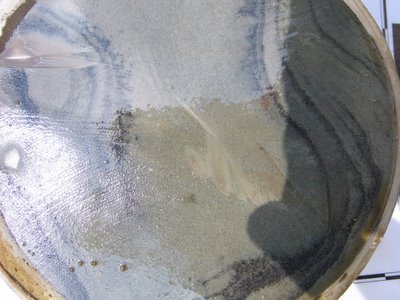

Attempted to swim out from east end of the island to the eastern barrier/ fringing reef. Didn't get there. Partly through meeting this "cleaner station" (?) on the reef top. Organisms : "brain coral" (fewer zombie jokes, please) ; sea urchins (one of 3 genera seen on this swim ; others have more robust spines in two different colours (which may or may not be important) ; the yellow-black striped fish is, I think, a "Sergeant Major" (distinguished from the Convict Surgeonfish by relatively thicker black bars, and the body being yellow above and silver-white below) ; and the blobby B+W fish looks like it should be a Clown Fish (stars of "Nemo: Found", or some film like that) ... and indeed, visually it looks like a "Saddleback clownfish". But that's a Western Indian Ocean species (not a problem itself ; coelacanths went one way, why couldn't something go the other way?, AND it should have a yellow mouth. Looking on the web ... there seem to be several closely similar species. And considerable intra-specific variation. So I'm not going to worry too much more about it.
Next!  Well , after leaving the "cleaning station, I carried on out toward the reef front. But things were getting gradually more interesting as the water very slowly got deeper. After 50mins of travel, I got to this area where - hard to see in static photos - there were in the order of 30 more "LBJ" shoaling around in the seaweed. Obviously, the brownness works for camouflage.
Well , after leaving the "cleaning station, I carried on out toward the reef front. But things were getting gradually more interesting as the water very slowly got deeper. After 50mins of travel, I got to this area where - hard to see in static photos - there were in the order of 30 more "LBJ" shoaling around in the seaweed. Obviously, the brownness works for camouflage.
Then ... horror of horrors ... the battery went flat!
Well there's a lesson : if swimming OUT to somewhere, try to do it on your back to avoid being distracted.
And that's me caught up to today!
 Well , after leaving the "cleaning station, I carried on out toward the reef front. But things were getting gradually more interesting as the water very slowly got deeper. After 50mins of travel, I got to this area where - hard to see in static photos - there were in the order of 30 more "LBJ" shoaling around in the seaweed. Obviously, the brownness works for camouflage.
Well , after leaving the "cleaning station, I carried on out toward the reef front. But things were getting gradually more interesting as the water very slowly got deeper. After 50mins of travel, I got to this area where - hard to see in static photos - there were in the order of 30 more "LBJ" shoaling around in the seaweed. Obviously, the brownness works for camouflage.Then ... horror of horrors ... the battery went flat!
Well there's a lesson : if swimming OUT to somewhere, try to do it on your back to avoid being distracted.
And that's me caught up to today!












